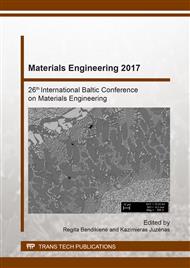[1]
E. Weidner, Analysis of the European crude tall oil industry – Environmental Impact, Socioeconomic Value & Downstream Potential (Fraunhofer Institute for Environmental, Safety and Energy Technology UMSICHT Report: EU CTO – Added value study, 2016).
Google Scholar
[2]
J.M. Anthonykutty, K.M. van Geem, R. de Bruycker, J. Linnekoski, A. Laitinen, J. Räsänen, Value added hydrocarbons from distilled tall oil via hydrotreating over a commercial NiMo catalyst, Ind. Eng. Chem. Res. 52 (2013) 10114-10125.
DOI: 10.1021/ie400790v
Google Scholar
[3]
J. Mikulec, A. Kleinová, J. Cvengroš, L. Joríková, M. Banič, Catalytic transformation of tall oil into biocomponent of diesel fuel, Int. J. of Chem. Eng. 2012 (2012) 1-9.
DOI: 10.1155/2012/215258
Google Scholar
[4]
M. Le Gall, D. Choqueuse, P.Y. Le Gac, P. Davies, D. Perreux, Novel mechanical characterization method for deep sea buoyancy material under hydrostatic pressure, Polymer Testing 39 (2014) 36-44.
DOI: 10.1016/j.polymertesting.2014.07.009
Google Scholar
[5]
X. Zhang, W. Fu, C. Duan, H. Xiao, M. Shi, N. Zhao, J. Xu, Super hydrophobicity determines the buoyancy performance of kapok fiber aggregates, Appl. Surf. Sci. 266 (2013) 225-229.
DOI: 10.1016/j.apsusc.2012.11.153
Google Scholar
[6]
S. Jumat, N. Saliha, E. Yousif, Industrial development and applications of plant oils and their biobased oleochemicals. Arabian J. Chem. 5 (2012) 135-145.
DOI: 10.1016/j.arabjc.2010.08.007
Google Scholar
[7]
L. Montero de Espinosa, M.A.R. Meie, Plant oils: the perfect renewable resource for polymer science, Eur. Polym. J. 47 (2011) 837-852.
DOI: 10.1016/j.eurpolymj.2010.11.020
Google Scholar
[8]
S. Caillol, M. Desroches, G. Boutevin, C. Loubat, R. Auvergne, B. Boutevin, Synthesis of new polyester polyols from epoxidized vegetable oils and biobased acids, Eur. J. Lipid. Sci. Technol. 114 (2012) 1447-1459.
DOI: 10.1002/ejlt.201200199
Google Scholar
[9]
R. Vasconcelos Vieira Lopes, N.P.D. Loureiro, A.P.T. Pezzin, A.C.M. Gomes, I.S. Resck, M.J.A. Sales, Synthesis of polyols and polyurethanes from vegetable oils-kinetic and characterization, J. Polym. Res. 20 (2013) 238-247.
DOI: 10.1007/s10965-013-0238-x
Google Scholar
[10]
U. Stirna, U. Cabulis, I. Beverte, Water blown polyisocyanurate foams from vegetable oil polyols, J. Cell. Plast. 44 (2008) 139-160.
DOI: 10.1177/0021955x07084705
Google Scholar
[11]
A. Fridrihsone, U. Stirna, B. Lazdina, M. Misane, D. Vilsone, Characterization of polyurethane networks structure and properties based on rapeseed oil derived polyol, Eur. Polym. J. 49 (2013) 1204-1214.
DOI: 10.1016/j.eurpolymj.2013.03.012
Google Scholar
[12]
M. Kuranska, A. Prociak, M. Kirpluks, U. Cabulis, Porous polyurethane composites based on bio-components, Compos. Sci. Technol. 75 (2013) 70-76.
Google Scholar
[13]
A. Prociak, M. Kuranska, E. Malevska, Porous polyurethane plastics synthetized using bio-polyols from renewable raw materials, Polimery. 62 (2017) 353-363.
DOI: 10.14314/polimery.2017.353
Google Scholar
[14]
R.L. Sandridge, Polyurethane foam from hydroxyled tall oil, Patent 3211674, USA, (1965).
Google Scholar
[15]
H. Piechota, H. Wirtz, Polyurethane foam prepared from the tall oil ester, Patent 3248348, USA, (1966).
Google Scholar
[16]
A. Ivdre, G. Soto, U. Cabulis, Polyols based on poly(ethylene terephthalate) and tall oil: perspectives for synthesis and production of rigid polyurethane foams, J. Ren. Mat. 4 (2016) 285-293.
DOI: 10.7569/jrm.2016.634122
Google Scholar
[17]
U. Cabulis, M. Kirpluks, U. Stirna, M.J. Lopez, M.C. Vargas-Garcia, F. Suarez-Estrella, J. Moreno, Rigid polyurethane foams obtained from tall oil and filled with natural fibers: application as a support for immobilization of lignin-degrading microorganisms, J. Cell. Plast. 48 (2012).
DOI: 10.1177/0021955x12443142
Google Scholar
[18]
Thermal insulation materials made of rigid polyurethane foam (PUR/PIR) (Federation of European Rigid Polyurethane Foams Associations, Report No. 1, Oct, 2006).
DOI: 10.3403/30315082
Google Scholar


